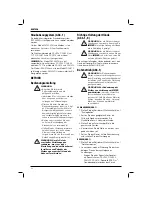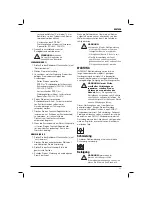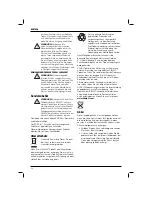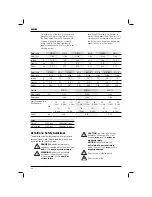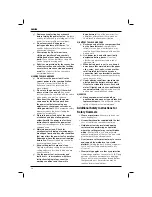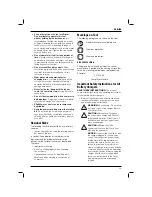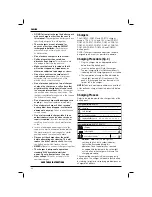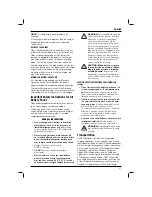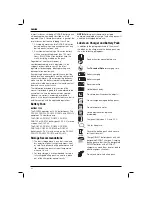
46
ENGLISH
•
Always hold the tool firmly with both
hands and ensure a secure stance.
Always operate the tool with the side
handle properly mounted.
WARNING: To reduce the risk of
serious personal injury, turn tool
off and disconnect battery pack
before making any adjustments or
removing/installing attachments
or accessories.
Proper Hand Position (fi g. 1, 6)
WARNING:
To reduce the risk of
serious personal injury,
ALWAYS
use proper hand position as shown
in figure 6.
WARNING:
To reduce the risk of
serious personal injury,
ALWAYS
hold securely in anticipation of a
sudden reaction.
Proper hand position requires one hand on the
main handle (h), with the other hand on the side
handle (e).
Drill Operation (fi g. 1)
WARNING:
To reduce the risk of
serious personal injury, turn tool off
and disconnect tool from power
source before making any adjustments
or removing/installing attachments
or accessories.
WARNING: To reduce the risk of
personal injury, ALWAYS
ensure
workpiece is anchored or clamped
firmly. If drilling thin material, use a wood
“back-up” block to prevent damage to
the material.
HAMMERDRILLING (FIG. 1)
1. Set the mode selector switch (c) to the "rotary
hammering" position.
2. Insert the appropriate drill bit. For best results
use high quality carbide-tipped bits.
3. Adjust the side handle (e) as required.
4. Mark the spot where the hole is to be drilled.
5. Place the drill bit on the spot and switch on
the tool.
ROTARY DRILLING (FIG. 1)
1. Set the mode selector switch (c) to the "rotary
drilling" position.
2. Depending on your tool, follow either of the
following instructions:
WARNING:
Never use standard chucks
in the rotary hammering mode.
Overload Clutch
There are two different types of overload clutch
fitted. The DCH143, DCH243, DCH253 and
DCH254 have a mechanical overload clutch, the
DCH273 and DCH274 have an electronic overload
clutch fitted.
In case of jamming of a drill bit, the drive to the
drill spindle is interrupted. On units fitted with a
mechanical clutch the indication that the clutch has
activated will be an audible ratcheting together with
increased vibration. If the electronic clutch activates
the motor is repeatedly switched on and off for a few
seconds to replicate the feedback associated with a
mechanical clutch. Release and depress the trigger
to re-engage drive.
Because of the resulting forces, always hold the tool
with both hands and take a firm stance.
Dust Extraction System (fi g. 1)
A dedicated integrated dust extraction
system (D25303DH) is available and can be
purchased separately.
To operate the D25303DH uses an electrical
connection (t) to the rotary hammer.
The DCH253, DCH254 (TYPE 2 Only), DCH273,
and DCH274 rotary hammer models are equipped
with the electrical connection (t).
NOTE:
The D25303DH is not compatible with
the DCH143, DCH243 or TYPE 1 versions of the
DCH253 and DCH254.
The DCH274 is available supplied complete with a
D25303DH and extended kit box as the DCH275.
OPERATION
Instructions for Use
WARNING:
• Always observe the safety instructions
and applicable regulations.
•
Be aware of the location of pipework
and wiring.
•
Apply only a gentle pressure to
the tool (approx. 5 kg). Excessive
force does not speed up drilling but
decreases tool performance and may
shorten tool life.
•
Do not drill or drive too deep to
prevent damage to the dust cover (o).
Summary of Contents for DCH143
Page 1: ...DCH143 DCH243 DCH253 DCH254 DCH273 DCH274 ...
Page 3: ...1 DANSK Figure 1 e s a c b h r f d t j i u g k Figure 2 b m l o ...
Page 4: ...2 DANSK Figure 3 Figure 5 f g Figure 4 m l f n o r ...
Page 5: ...3 DANSK Figure 6 q p l p Figure 7 DCH254 DCH274 ...
Page 206: ...204 ...
Page 207: ...205 ...

